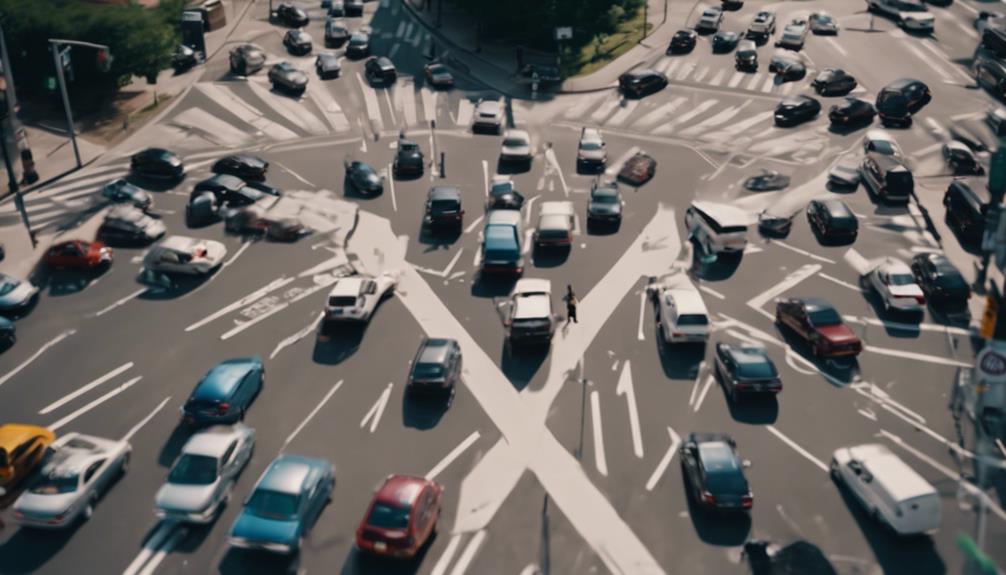In North Carolina, folks don’t need to pass a road sign test for license renewals anymore thanks to Governor McCrory’s update. Now, the focus is on vision testing. This ensures our eyesight is good enough for safe driving. For Class A, B, and C license renewals, the vision test has to be done face-to-face. Expect a bit of a wait during the renewal process. This change boosts efficiency at the DMV and improves customer service. By skipping the road sign test, the whole renewal experience becomes smoother, still making sure drivers are competent. Want to know everything about the license renewal process? Keep reading!
Key Takeaways
- North Carolina no longer requires a road sign test for license renewal.
- The focus shifted to vision testing for Class A, B, and C license renewals.
- Vision testing is mandatory for in-person renewals to ensure safe driving.
- Governor McCrory's initiative aimed to streamline the renewal process.
- The change aims to enhance efficiency and customer service at DMV offices.
History of Road Sign Test in NC
For years, North Carolina drivers routinely underwent a road sign test as part of the license renewal process. This test was an essential component in ensuring that drivers were aware of and understood the various road signs that they'd encounter while driving. By requiring drivers to demonstrate their knowledge of road signs, the test aimed to enhance overall road safety and reduce the risk of accidents caused by confusion or ignorance of traffic signs.
The road sign test for license renewal in North Carolina was designed to assess drivers' ability to recognize and interpret the colors and shapes of different road signs accurately. By successfully completing this test, drivers demonstrated their readiness to navigate the roads responsibly and in compliance with traffic regulations. This requirement was put in place to uphold high standards of safety and proficiency among licensed drivers in the state. The test served as a valuable tool for ensuring that drivers remained informed and up to date on essential traffic sign information.
Governor's Driving Change Initiative

In the context of the Governor's Driving Change Initiative, we'll now address the significance of Governor McCrory's efforts in modernizing license renewal processes.
This initiative, which abolished the road sign test requirement in North Carolina, aimed to enhance efficiency at DMV offices and simplify the renewal procedure for all Class A, B, and C license holders.
Governor's Initiatives
Governor Pat McCrory's Driving Change Initiative in North Carolina has successfully streamlined the license renewal process by eliminating the road sign test requirement.
The initiative prioritizes efficiency at DMV offices.
It focuses on simplifying the license renewal process.
Class A, B, and C license renewals are included in the policy change.
In-person vision testing is now emphasized over road sign identification.
Governor McCrory's initiative underscores a commitment to modernization and customer service improvements.
These changes align with North Carolina's goal of enhancing the overall driver licensing procedures by removing the need for road sign identification during license renewal, marking a significant shift in the state's approach to licensing requirements.
Road Sign Testing
Under Governor Pat McCrory's Driving Change Initiative in North Carolina, the focus has shifted from road sign testing to prioritizing vision testing for in-person license renewals.
NC no longer requires a road sign test for license renewals, benefiting regular Class A, B, and C license holders by exempting them from the road sign identification test during renewal.
Vision testing now takes precedence in North Carolina, aiming to streamline the renewal process and enhance customer service at DMV offices.
This change reflects the state government's commitment to efficiency and modernization in licensing procedures, ensuring a smoother experience for NC drivers seeking to renew their licenses.
Vision Test Requirement for Renewal
When renewing your driver's license in North Carolina, it's important to remember that a vision test is a key requirement. This test guarantees that we can see clearly and safely while driving on the roads.
Make sure to visit the DMV prepared for this part of the renewal process.
Vision Test Process
During the in-person license renewal process in North Carolina, drivers are required to undergo a vision test that includes reading the top line in the viewfinder and identifying yellow, red, and green number boxes.
- The vision test confirms drivers have adequate vision for safe driving.
- Reading the top line in the viewfinder checks distance vision.
- Identifying colored number boxes evaluates color vision.
This process simplifies renewal requirements.
Confirming good vision is essential for road safety.
Renewal Requirements
As drivers in North Carolina seek to renew their licenses, they are now required to undergo a vision test instead of a road sign test, aligning with the state's updated renewal requirements. This change, part of Governor Pat McCrory's efficiency initiative, aims to streamline DMV operations. The vision test is mandatory for in-person renewals for Class A, B, and C license holders. By focusing on vision rather than road signs, the renewal process becomes more efficient and customer-friendly. Below is a table summarizing the renewal requirements for North Carolina drivers:
| Renewal Requirement | Vision Test |
|---|---|
| Class A License | Yes |
| Class B License | Yes |
| Class C License | Yes |
Drivers can now expect a quicker and smoother license renewal experience.
Class A License Renewal Process

For Class A license renewal in North Carolina, applicants must undergo in-person vision testing instead of a road sign test. When renewing a Class A license, there are specific procedures to follow:
- In-Person Vision Testing: Unlike the Sign Test for Drivers License renewal, Class A license holders are required to undergo vision testing in person.
- No Road Sign Test: Unlike Class B and C drivers, Class A license holders don't need to take a road sign test for renewal.
- Renewal Appointments: Renewal appointments for Class A licenses may have long wait times, sometimes extending into January or March.
- In-Person Renewal: The renewal process for Class A licenses must be done in person and can't be completed online.
- Road Signs Tested: During the renewal process, specific road signs like School crossing, no passing, and RR Crossing are tested.
Understanding these requirements is vital for ensuring a smooth renewal process for your Class A license with the NC DMV.
Class B License Renewal Process

In North Carolina, when renewing a Class B license, we no longer need to take the road sign test. Instead, the main requirement is a vision test.
This change is part of an efficiency initiative by Gov. Pat McCrory.
Renewal Requirements
Streamlining the Class B license renewal process in North Carolina now focuses primarily on vision testing, eliminating the need for a road sign test. As part of Governor Pat McCrory's initiative to improve efficiency and customer service at the DMV, the renewal requirements have been updated. Here are the key points regarding the Class B license renewal process:
- Vision testing is the primary requirement for in-person license renewals.
- The policy change aims to enhance the efficiency of DMV procedures.
- Renewal process for Class B licenses has been streamlined to prioritize vision testing.
- The emphasis is on improving customer service during the renewal process.
- The new policy applies to various classes of driver licenses, including Class B.
Exam Exemption
Efficiently streamlining the Class B license renewal process in North Carolina, the road sign test requirement has been removed, making vision testing the primary focus. This change, part of Gov. Pat McCrory's initiative for efficiency in licensing procedures, exempts regular Class B driver licenses from the road sign test. Renewing Class B license holders no longer need to identify colors and shapes of road signs. Below is a table summarizing the key points regarding the recent policy change in NC for Class B license renewals:
| Driving Policy Change | NC License Renewal | Class B License Holders |
|---|---|---|
| Road Sign Test | No Longer Required | Exemption Applies |
| Vision Testing | Primary Focus | No Color/Shape ID |
This table highlights the updated requirements and exemptions for Class B license renewals in North Carolina.
Class C License Renewal Process

The process for renewing a Class C license in North Carolina now primarily focuses on in-person vision testing, with the removal of the road sign identification requirement. This change, part of Gov. Pat McCrory's initiative for efficiency in licensing procedures, aims to streamline the renewal process for Class C drivers.
- In-Person Vision Testing: Renewal now involves a vision test conducted in person.
- Exemption for Experienced Drivers: Experienced Class C drivers are exempt from the road sign identification test.
- Governor's Initiative: The change aligns with Gov. McCrory's goal of enhancing efficiency in licensing processes.
- Streamlining Renewal: The policy shift seeks to make the license renewal process smoother for Class C drivers.
- Enhanced Procedures: The focus on vision testing ensures that drivers meet the required visual acuity standards for safe driving.
These modifications aim to improve the renewal process while maintaining the safety standards for all Class C license holders in North Carolina.
Benefits of Eliminating Road Sign Test

Eliminating the road sign test for license renewal in North Carolina has greatly streamlined the renewal process for experienced drivers. By removing the requirement to identify colors and shapes of road signs, the focus has shifted towards vision testing during in-person renewals. This change not only allows drivers to concentrate on essential aspects of safe driving but also enhances efficiency at DMV offices.
Governor Pat McCrory's initiative for efficiency, known as Driving Change, drove the decision to eliminate the road sign test, aiming to improve customer service. As a result, experienced drivers can now renew their licenses more quickly, reducing wait times and bureaucratic hurdles. This alteration benefits both drivers and DMV staff, ensuring that the renewal process is smoother and more focused on critical aspects of driving competence.
Impact on Driver Convenience

With the road sign test no longer required for license renewal in North Carolina, drivers experience a more streamlined and convenient process. This change enhances efficiency and improves customer satisfaction. The impact on driver convenience is significant, benefiting North Carolina drivers in several ways:
- Time Savings: Eliminating the road sign test saves drivers time during the renewal process.
- Reduced Stress: Drivers no longer need to worry about memorizing road signs, making the renewal process less stressful.
- Focus on Vision Testing: The shift towards vision testing for in-person renewals guarantees that drivers meet essential requirements without unnecessary hurdles.
- Improved Renewal Experience: Exempting experienced drivers from the road sign test streamlines the renewal experience, making it smoother and more convenient.
- Enhanced Customer Service: This change aligns with modernization efforts, enhancing customer service at DMV offices and improving the overall experience for license holders.
Comparison With Other States' Renewal Procedures

Shifting our focus to the renewal procedures in other states reveals varying requirements for license renewal, especially when it comes to road sign testing. While North Carolina has eliminated the need for a road sign test, states like California and New York still mandate road sign identification for license renewal. In North Carolina, the emphasis has shifted towards vision testing for in-person license renewals, aligning with efforts to streamline the renewal process. Unlike in the past, drivers in North Carolina no longer need to identify colors and shapes of road signs to renew their licenses.
Compared to North Carolina's current procedures, some states continue to prioritize road sign knowledge as part of their renewal process. Understanding these differences can provide insight into the evolving standards across different states. As North Carolina focuses on vision testing, other states maintain the road sign test requirement, highlighting the diverse approaches taken to promote road safety and driver competency during the renewal process.
Future Updates on NC License Renewals

We anticipate upcoming modifications to the renewal process for North Carolina driver's licenses. As the state continues to refine its policies, here are some potential changes that may impact license renewals:
- Online Renewal Options: The DMV might introduce online renewal options to enhance convenience for drivers.
- Mobile Renewal Units: There could be the introduction of mobile renewal units to reach more remote areas efficiently.
- Renewal Reminders: Implementing automated renewal reminders via email or text messages to guarantee timely renewals.
- Reduced Wait Times: Efforts to streamline the renewal process at DMV offices to minimize wait times for customers.
- Enhanced Customer Service: Focus on improving customer service during the renewal process by providing clearer instructions and assistance.
These changes aim to simplify the renewal process, making it more accessible and efficient for North Carolina drivers. Stay updated on the latest developments to ensure a smooth renewal experience.
Frequently Asked Questions
Do I Have to Take a Sign Test to Renew My License in Nc?
We don't need to take a sign test to renew our license in North Carolina anymore. The new policy only requires vision testing for in-person renewals.
However, first-time drivers in NC still have to pass sign and symbol testing. This change aligns with Governor Pat McCrory's goal to improve licensing processes.
What Tests Are Required for NC Drivers License Renewal?
For North Carolina driver's license renewal, only a vision test is required. This change eliminates the road sign test for renewals.
If renewing in person, you'll need to retake the vision test. However, online renewals are exempt from the road sign test.
This shift emphasizes vision while maintaining road safety standards.
Do You Have to Take a Road Sign Test to Get Your License in Nc?
Yes, in North Carolina, a road sign test is required for first-time license applicants. However, for license renewals, drivers are no longer obligated to take the road sign test.
This change benefits experienced drivers seeking to renew their licenses, with a focus now on vision testing during in-person renewals. As a result, for renewing a license in NC, the road sign test is no longer a requirement.
What Do I Have to Do to Renew My Driver's License in Nc?
To renew your driver's license in NC, you'll need to primarily pass a vision test in person. This change was part of Gov. Pat McCrory's effort to streamline DMV operations.
Regular Class A, B, and C licenses in North Carolina no longer require a road sign test for renewal. However, first-time drivers must still take the sign and symbol test when applying for a license.
This revision aims to enhance efficiency at DMV offices.
Do I Need to Take a Road Sign Test for License Renewal in NC if My Chaco Sandals Have a Lifetime Warranty?
When renewing your license in NC, you won’t have to take a road sign test if your Chaco sandals have a lifetime warranty. However, it’s essential to check the specific chaco lifetime warranty information to ensure your sandals are still covered.
Conclusion
To sum up, renewing your driver's license in North Carolina no longer requires a road sign test. This change makes the process quicker and more convenient for drivers.
Remember to always stay up to date with any future updates on NC license renewals. This change is a positive step towards simplifying the renewal process, making it easier for everyone.
It's like a welcome change in the world of bureaucratic procedures.











